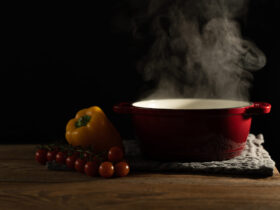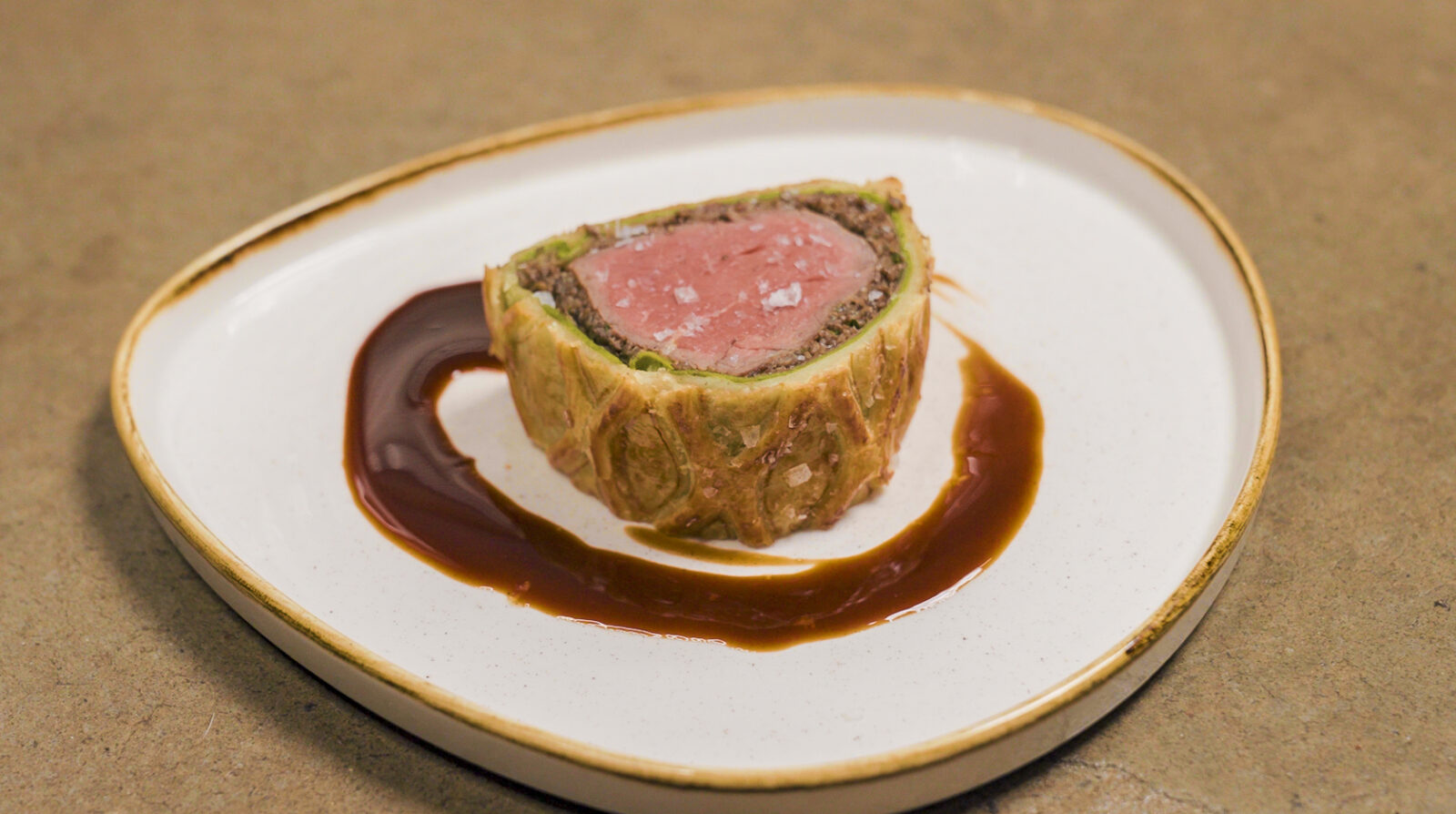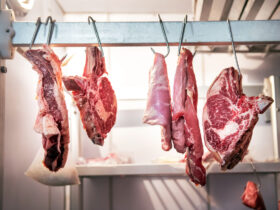What is a perfect Beef Wellington?
A perfect Beef Wellington boasts a crispy puff pastry shell, a succulent filling infused with delicate mushrooms, and a flawlessly cooked beef tenderloin. The true art lies in ensuring that no juices escape when slicing, preserving the crispness of the puff pastry.
The often trickiest part? A beef tenderloin that is cooked precisely right. We want to show you how to perfectly prepare this dish every time – from preparing your “mise en place” to confidently presenting it during service. With this, you can always create a masterpiece on the plate while staying relaxed.

The History of Beef Wellington
In the culinary history, the exact origin of Beef Wellington often remains unclear, with various versions existing regarding the dish’s origins.
It is speculated that it may have originated in France and was inspired by a similar recipe called “filet de bœuf en croûte” – a beef fillet in a pastry crust.
A widely accepted theory is that the name of the dish comes from Arthur Wellesley, the 1st Duke of Wellington. This famous British military leader defeated Napoleon at the Battle of Waterloo. Legend has it that the Duke enjoyed a dish consisting of beef, mushrooms, and a crust, which later became known as Beef Wellington.
There are various variations of Beef Wellington, but traditionally it consists of a piece of beef tenderloin – often the Chateaubriand, the thickest part of the tenderloin. This is first seared and then brushed with mustard to intensify the flavor. The fillet is then wrapped in Parma ham and a mixture of finely chopped mushrooms, shallots, and herbs (called Duxelles), before being encased in puff pastry. It is then baked in the oven until the pastry is golden brown and the meat reaches the desired level of doneness.
Despite the uncertain origin of Beef Wellington, this elegant dish remains a popular centerpiece often served on special occasions.

Every time, a perfectly cooked beef tenderloin in your Beef Wellington
How to achieve a perfectly cooked beef tenderloin for your Beef Wellington every time? It can be disappointing when, after all the effort, the fillet is either overcooked or still too raw.
Experience can help in knowing how long and at what temperature to cook the Beef Wellington in the oven perfectly. Alternatively, you can use a meat thermometer to check the doneness.
However, a better and simpler method is to pre-cook the beef tenderloin to the desired level of doneness at a controlled, low temperature – preferably using the sous vide method. This ensures that the meat remains tender and juicy.
We season the beef tenderloin, sear it on all sides to create a nice browning and the Maillard reaction. Then, we cook it at a low temperature using the sous vide method until it reaches the desired level of doneness and then cool it in the refrigerator.
By using the pre-cooked beef tenderloin in our Beef Wellington, we no longer have to worry about the doneness of the meat. Instead, we focus on getting the puff pastry crispy and heating the interior. As the Beef Wellington consists of multiple layers, there is no risk of the beef tenderloin continuing to cook.

Why does the crepe in your Beef Wellington make a difference?
We’re not just aiming for a beautiful, but a perfect Beef Wellington. Even with crispy puff pastry and a perfectly cooked beef tenderloin, there can be an issue.
When sliced, the juices from the mushrooms and the beef tenderloin leak out, causing the bottom of the Beef Wellington to become soggy and lose its desired crispiness.
There’s a solution to this problem: we incorporate an additional layer into our Beef Wellington – a crepe. The crepe acts as a barrier between the puff pastry and the rest of the Beef Wellington. In our recipe, we use a spinach crepe, which complements the flavors well and provides a nice color contrast when sliced. This preserves the crispiness of the puff pastry while ensuring a juicy and flavorful Beef Wellington.

Our Hack for the Crepe
One might note that using crepes as an additional layer is a nice idea but it also means extra work. Even when making round crepes in a pan, it can be tricky to roll up a Beef Wellington. If you layer two crepes on top of each other, you may end up with either thin edges or a too thick center.
That’s why we bake our crepes for Beef Wellington in a rectangular shape. To do this, we mix all the ingredients in a blender and bake the crepes on a greased baking sheet at 120°C in the oven. This method is not only easier and faster, but also allows us to incorporate the crepes better into the Beef Wellington.
By the way, this method is always handy when you need to make a large quantity of crepes quickly. Since we’re not frying the batter, the spinach crepe stays beautifully green in the oven.

Preparing and Freezing Beef Wellington
The prepared Beef Wellington is excellent for freezing, allowing you to prepare it in advance.
To do this, prepare the recipe up to the point of wrapping it with the crepe, then wrap the package in plastic wrap and either freeze it or, preferably, shock freeze it. Then, vacuum seal it and store it in the freezer.
When needed, thaw the Beef Wellington slowly, then wrap it with puff pastry before finishing baking it in the oven.

The puff pastry for the Beef Wellington
For Beef Wellington, you can use various types of pastry, but the most commonly used pastry is puff pastry. You can either buy puff pastry ready-made or make it yourself. If you’d like to learn how to make puff pastry from scratch, you can also learn this from us.
What's the deal with Duxelles?
Duxelles is a mixture of finely chopped mushrooms commonly used in various dishes in the kitchen. Although various types of mushrooms can be used, mushrooms are often the preferred choice.
The mushrooms are either finely diced with a knife or quickly chopped in a food processor, being careful not to create a puree-like consistency. To prepare the Duxelles, finely chopped shallots are sautéed with some garlic and herbs. Then, the chopped mushrooms are added and cooked until all the moisture has evaporated.
Duxelles can be prepared in advance and stored covered or vacuum-sealed in the refrigerator for up to 4 days.














Leave a Reply
View Comments